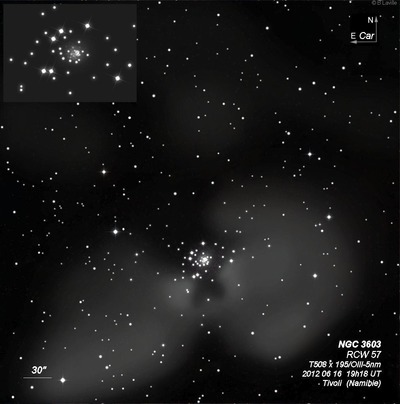
John Herschel discovered NGC 3603 = h3334 on 14 Mar 1834 NGC 3603 and recorded "a red star 10m, the centre of an excessively condensed group of stars 15...18m, with a nebulosity extending over 2' diameter. On the next sweep, he noted "the center, when examined with powers 240 and 320, decidedly not a star, and the nebula about it all resolved. Perhaps it is a globular clusters, vs vvmbM."
In 1928, Willem van den Bos examined the central "star" with the 26.5-inch refractor at the Union Observatory in Johannesburg and found "the central star to be a close double, B 1184, with many faint stars near." He measured the AB pair as 0.6" separation in PA 98°, with the "C" component at 1.8" in PA 75° and the D component (I 1132) at 2.7" in PA 259°. He also noted "The central double is red or at least decidedly reddish, though the spectral type is given as Oe in the Draper Catalogues..."
300/350mm - 13.1" (2/20/04 - Costa Rica): at 105x a bright irregular nebula surrounds a mag 9 "star". At 200x, a half-dozen very faint stars are packed very close to the central star. This very compact knot is actually a distant, very dense, super star cluster (SSC) of extremely luminous stars! Adding a UHC filter, the nebulosity is irregular at 105x, extending mostly south of the star and fading out into two or three sections that are possibly divided by a dark lane. The brightest section is to the southwest of the central star.
400/500mm - 18" (7/7/02 - Magellan Observatory, Australia): at 228x this distant but superluminous HII region is a fascinating clump of stars of and nebulosity surrounding a bright 9th magnitude knot. The bright central region was extremely dense and contained 10-12 stars crammed into 2', yet it seemed only partially resolved at the very center into a couple of stars. At 128x and UHC filter, the surrounding "haze" is clearly gaseous in nature with the brightest portion offset to the SW side from the core with a roughly broad fan with a total size of approximately 5'x3'. A dark lane appears to cut through the nebulosity towards the core and there is a strong impression that the field is riddled with dust lanes and patches. This is a well-studied highly reddened, luminous cluster (~20,000 light years) and HII region with similarities to the Tarantula nebula in the LMC!
600/800mm - 24" (4/5/08 - Magellan Observatory, Australia): this distant (20,000 light years) superluminous HII region and cluster was mesmerizing at 200x using a UHC filter. The nebulosity was generally elongated E-W, ~5'x3', but with bays and extensions and dark lanes. The surface brightness was highest to the south of the embedded cluster with a dark lane slashing through the nebulosity just west of the bright core. At 350x, 15-20 stars were resolved in the glow, though the tiny, brilliant "core" cluster (HD 97950) was only mottled and barely resolved into a few stars.
Notes by Steve Gottlieb